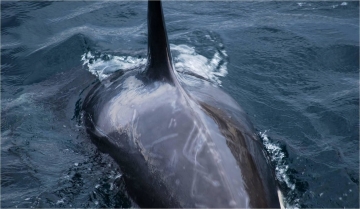680423_Sibling Play_360 px width.jpg

White scars on the backs and sides of southern resident killer whales most likely the result of play between siblings. Credit: Lynn Aderholt, U.S. National Park Service.
Young killer whales off the coast of Washington and British Columbia like to nip at each other. That leaves white scars on their backs and sides—but they’re not permanent. That allows biologists to use the scars to learn about the life histories of these endangered animals.
They’re looking at southern resident killer whales—the smallest of the four types of resident killer whales. There are only 73 known members. They live in family groups, with the offspring staying with their mothers all their lives.
A recent study analyzed 38 years of photographs of the southern residents. Scientists identified individual whales from the patterns of scratches, known as rakes. Over the years, early rakes fade away, while new ones appear. That allowed the scientists to track changes, revealing patterns in interactions between the whales.
Perhaps not surprisingly, rakes are more common on younger whales, and on males rather than females.
The researchers suggest that most of the scars are the result of play between siblings. But there could be a more serious purpose, as the whales try to move up in the family pecking order.
Researchers also found that the number of rakes went up when the whales’ main food supply, Chinook salmon, was most abundant. That could be because more whales congregate then. Or it could be because the extra food gives the whales more pep for horseplay—make that whale play—so the youngsters have plenty of energy to nip at their friends and family.

